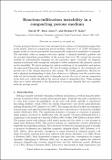Files in this item
Reaction-infiltration instability in a compacting porous medium
Item metadata
| dc.contributor.author | Rees Jones, David W. | |
| dc.contributor.author | Katz, Richard F. | |
| dc.date.accessioned | 2019-07-03T14:30:08Z | |
| dc.date.available | 2019-07-03T14:30:08Z | |
| dc.date.issued | 2018-10-10 | |
| dc.identifier | 259433665 | |
| dc.identifier | 6a30610b-5b37-4822-90c1-3c3813617090 | |
| dc.identifier | 85051109579 | |
| dc.identifier.citation | Rees Jones , D W & Katz , R F 2018 , ' Reaction-infiltration instability in a compacting porous medium ' , Journal of Fluid Mechanics , vol. 852 , pp. 5-36 . https://doi.org/10.1017/jfm.2018.524 | en |
| dc.identifier.issn | 0022-1120 | |
| dc.identifier.other | ORCID: /0000-0001-8698-401X/work/59222357 | |
| dc.identifier.uri | https://hdl.handle.net/10023/18037 | |
| dc.description | Funding: D.W.R.J. acknowledges research funding through the NERC Consortium grant NE/M000427/1. | en |
| dc.description.abstract | Certain geological features have been interpreted as evidence of channelized magma flow in the mantle, which is a compacting porous medium. Aharonov et al. (J. Geophys. Res., vol. 100 (B10), 1995, pp. 20433-20450) developed a simple model of reactive porous flow and numerically analysed its instability to channels. The instability relies on magma advection against a chemical solubility gradient and the porosity-dependent permeability of the porous host rock. We extend the previous analysis by systematically mapping out the parameter space. Crucially, we augment numerical solutions with asymptotic analysis to better understand the physical controls on the instability. We derive scalings for the critical conditions of the instability and analyse the associated bifurcation structure. We also determine scalings for the wavelengths and growth rates of the channel structures that emerge. We obtain quantitative theories for and a physical understanding of, first, how advection or diffusion over the reactive time scale sets the horizontal length scale of channels and, second, the role of viscous compaction of the host rock, which also affects the vertical extent of channelized flow. These scalings allow us to derive estimates of the dimensions of emergent channels that are consistent with the geologic record. | |
| dc.format.extent | 32 | |
| dc.format.extent | 2956709 | |
| dc.language.iso | eng | |
| dc.relation.ispartof | Journal of Fluid Mechanics | en |
| dc.subject | Geophysical and geological flows | en |
| dc.subject | Porous media | en |
| dc.subject | Reacting multiphase flow | en |
| dc.subject | QC Physics | en |
| dc.subject | QE Geology | en |
| dc.subject | Mechanical Engineering | en |
| dc.subject | Mechanics of Materials | en |
| dc.subject | Condensed Matter Physics | en |
| dc.subject | T-NDAS | en |
| dc.subject | BDC | en |
| dc.subject.lcc | QC | en |
| dc.subject.lcc | QE | en |
| dc.title | Reaction-infiltration instability in a compacting porous medium | en |
| dc.type | Journal article | en |
| dc.contributor.institution | University of St Andrews. Applied Mathematics | en |
| dc.identifier.doi | 10.1017/jfm.2018.524 | |
| dc.description.status | Peer reviewed | en |
| dc.date.embargoedUntil | 2019-02-02 | |
| dc.identifier.url | https://ora.ox.ac.uk/objects/pubs:892211 | en |
This item appears in the following Collection(s)
Items in the St Andrews Research Repository are protected by copyright, with all rights reserved, unless otherwise indicated.

